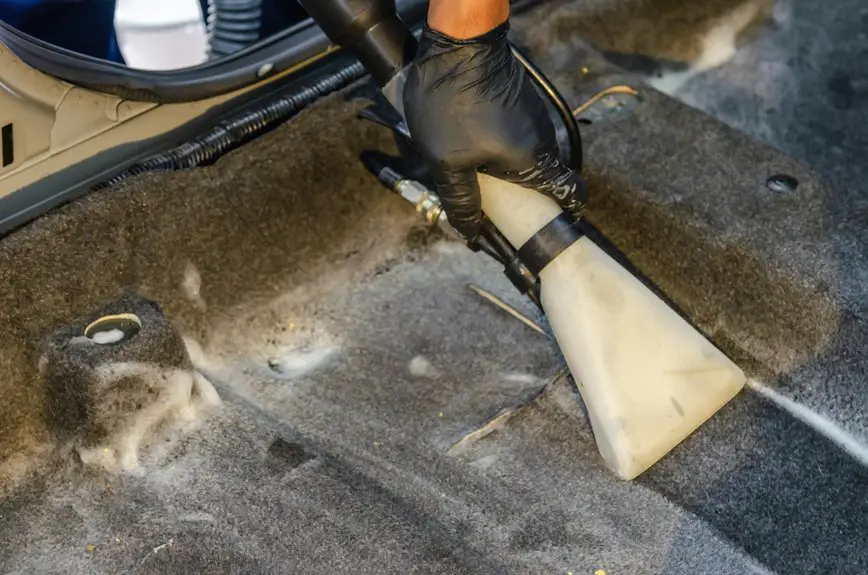You can easily make an all-natural upholstery cleaner and deodorizer with simple ingredients. Mix 1 cup of white vinegar, 1 tablespoon of dish soap, and 2 cups of water in a spray bottle. Shake it well before use. For added freshness, include 1/2 cup of baking soda. This effective solution is safe for your family and pets, and helps maintain a healthy environment. Keep exploring for more tips on upholstery care and cleaning techniques!
Table of Contents
Key Takeaways
- Create a simple upholstery cleaner using 1 cup of white vinegar, 1 tablespoon of dish soap, and 2 cups of water in a spray bottle.
- Add 1/2 cup of baking soda for extra deodorizing power and freshness in your cleaning solution.
- Test your cleaning solution on a hidden fabric area to ensure it won’t cause damage before applying it to the entire surface.
- Use soft brushes or microfiber cloths to gently blot stains without scratching delicate upholstery materials.
- Enhance odor elimination by placing activated charcoal near upholstery for continuous deodorizing without harsh chemicals.
Understanding the Benefits of Natural Cleaners
Have you ever wondered why natural cleaners are gaining popularity? People like you’re increasingly seeking eco-friendly alternatives to traditional cleaning products.
Natural cleaners are safer for your health, reducing exposure to harmful chemicals that can irritate skin or trigger allergies. You’ll appreciate that they’re often biodegradable, contributing to a healthier planet by minimizing pollution.
Plus, using these cleaners means you’ll avoid the harsh scents that accompany many commercial products, making your home feel fresher. They’re also versatile, working effectively on various surfaces without the risk of damage.
Embracing natural cleaners not only benefits your living space but also supports sustainable practices, giving you peace of mind while you clean.
Essential Ingredients for Your DIY Upholstery Cleaner
With the growing interest in natural cleaning solutions, creating your own upholstery cleaner is a simple and effective way to maintain your furniture.
To get started, you’ll need a few essential ingredients that are safe and powerful. Here’s what you should gather:
- White Vinegar: It’s great for breaking down stains and neutralizing odors.
- Baking Soda: This natural deodorizer absorbs smells and can lift dirt when combined with water.
- Castile Soap: A gentle yet effective soap that cleans without harsh chemicals.
These ingredients work together to tackle dirt and odors, leaving your upholstery fresh and clean.
Plus, they’re all-natural, so you can feel good about using them in your home!
Simple Recipe for a Basic Upholstery Cleaner
Creating a basic upholstery cleaner at home is quick and straightforward. You’ll only need a few simple ingredients that you probably already have. Here’s an easy recipe to get you started:
| Ingredient | Amount | Purpose |
|---|---|---|
| White vinegar | 1 cup | Cuts grease and grime |
| Dish soap | 1 tablespoon | Breaks down dirt |
| Water | 2 cups | Dilutes the mixture |
| Baking soda | 1/2 cup (optional) | Adds freshness |
Mix these ingredients in a spray bottle. Shake well before each use, and you’re ready to clean! This combination effectively tackles stains and refreshes your upholstery, making your furniture look as good as new.
How to Use Baking Soda for Odor Removal
While you mightn’t realize it, baking soda is a powerful ally in the battle against unwanted odors in your upholstery.
To effectively use it, follow these simple steps:
- Sprinkle: Generously sprinkle baking soda over the affected areas of your upholstery. Make sure to cover all spots where odors linger.
- Let it Sit: Allow the baking soda to sit for at least 15 minutes, or up to a few hours for tougher odors. This gives it time to absorb the smells.
- Vacuum: Once the time’s up, vacuum the baking soda thoroughly. This will lift away the odors and leave your upholstery smelling fresh.
Using baking soda not only deodorizes but also refreshes your furniture without harsh chemicals!
Stain Removal Techniques for Different Upholstery Types
When tackling stains on upholstery, it’s essential to take into account the fabric type first.
Different materials require specific techniques and solutions for effective removal.
Understanding the stain types and corresponding cleaning methods will help you protect your furniture while keeping it looking its best.
Fabric-Specific Techniques
Understanding the specific fabric of your upholstery is essential for effective stain removal, as different materials require tailored techniques to prevent damage.
Here are three common upholstery types and their cleaning methods:
- Cotton: Use a mixture of water and mild dish soap to gently blot stains. Avoid soaking, as excess moisture can lead to mold.
- Leather: Wipe spills immediately with a soft, damp cloth. For deeper stains, use a solution of equal parts vinegar and water, but always test in an inconspicuous area first.
- Microfiber: For water-based stains, use a mixture of rubbing alcohol and water. For oil-based stains, a few drops of dish soap can work wonders.
Stain Types and Solutions
Different types of stains can be a challenge, but knowing the right solutions for each can make all the difference in keeping your upholstery looking fresh. Here’s a quick reference guide for tackling common stains:
| Stain Type | Solution | Upholstery Type |
|---|---|---|
| Coffee | Blot with cold water | Cotton, Polyester |
| Red Wine | Mix baking soda with water | Microfiber |
| Ink | Rubbing alcohol on a cloth | Leather |
For coffee stains, act fast and blot with cold water. Red wine requires a baking soda paste, while ink stains need a dab of rubbing alcohol. Always test your solution on an inconspicuous area first!
Tips for Testing Your Cleaner on Upholstery
How can you guarantee your homemade upholstery cleaner won’t damage your fabric? Testing is the key!
Here’s how to safely test your cleaner before using it on the entire piece:
- Spot Test: Apply a small amount of the cleaner to an inconspicuous area. Wait 10-15 minutes to see if any discoloration occurs.
- Observe Texture: After the cleaner dries, feel the fabric. It shouldn’t become stiff or rough.
- Check for Residue: Confirm there’s no sticky or greasy residue once it dries. This can attract dirt and cause further issues.
Maintaining Your Upholstery Between Cleanings
After ensuring your homemade upholstery cleaner is safe, it’s time to focus on keeping your furniture looking great between cleanings.
Start by regularly vacuuming your upholstery to remove dust and debris that can accumulate and wear down the fabric. Pay attention to crevices and cushions where dirt tends to hide.
If spills occur, blot them immediately with a clean cloth; don’t rub, as this can spread the stain.
Consider using throw blankets or slipcovers to protect high-traffic areas. Rotate cushions periodically to prevent uneven wear.
Finally, keep your upholstery away from direct sunlight to minimize fading.
Safe Cleaning Practices for Delicate Fabrics
When you’re dealing with delicate fabrics, it’s crucial to adopt safe cleaning practices to prevent damage.
Here are three key tips to keep in mind:
- Test First: Always test your cleaning solution on a hidden area first. This way, you can verify it won’t cause discoloration or damage.
- Gentle Tools: Use soft brushes or microfiber cloths for cleaning. Avoid abrasive materials that can scratch or wear out the fabric.
- Avoid Excess Moisture: Dampness can lead to mold or mildew. Use minimal liquid when cleaning, and verify the fabric dries completely afterward.
Additional Natural Deodorizers to Consider
If you’re looking to freshen up your upholstery naturally, there are several deodorizers you can easily incorporate into your cleaning routine.
Baking soda is a powerful option; just sprinkle it on your furniture, let it sit for a few hours, and vacuum it up to absorb odors.
Sprinkle baking soda on your furniture, let it sit, then vacuum to effectively absorb unwanted odors.
White vinegar is another excellent choice—mix it with water in a spray bottle and lightly mist your upholstery; the vinegar smell will dissipate, leaving your fabric fresh.
Essential oils, like lavender or eucalyptus, can also add a pleasant scent; mix a few drops with water and mist your upholstery.
Finally, activated charcoal is fantastic for absorbing odors—place bags of it near your furniture for a continuous deodorizing effect.
Eco-Friendly Cleaning: A Sustainable Choice
Choosing eco-friendly cleaning products not only benefits your upholstery but also supports a healthier environment. By opting for natural ingredients, you’re making a sustainable choice that reduces harmful chemicals in your home and the ecosystem.
Here are three reasons to switch to eco-friendly cleaners:
- Safer for Your Family: Natural cleaners typically contain no harsh chemicals, making them safer for kids and pets.
- Reduced Environmental Impact: Eco-friendly products minimize pollution and waste, helping to protect our planet’s resources.
- Cost-Effective: Many DIY solutions use common household items, saving you money while keeping your home clean and fresh.
Frequently Asked Questions
Can I Use This Cleaner on Leather Upholstery?
You might think all cleaners are safe for leather, but that’s not true. This cleaner’s ingredients could damage your leather upholstery. Always test a small, inconspicuous area before applying any cleaner to leather surfaces.
How Often Should I Clean My Upholstery?
You should clean your upholstery every six to twelve months, depending on usage and exposure to dirt. Regular maintenance keeps it looking fresh and extends its lifespan, so don’t let grime build up!
Is This Cleaner Safe for Pets?
Yes, this cleaner’s safe for pets. You can use it without worrying about harmful chemicals. Just make certain your pets aren’t on the upholstery while it dries, and they’ll be perfectly fine afterwards.
How Long Does the Deodorizing Effect Last?
Like a fresh breeze on a summer day, the deodorizing effect can last anywhere from a few days to a couple of weeks, depending on factors like humidity and air circulation in your space.
Can I Add Essential Oils for Scent?
Yes, you can definitely add essential oils for scent! Just a few drops will enhance the aroma. Experiment with different oils to find your favorite fragrance, and enjoy a fresh-smelling environment every time you clean.
- Can You Iron Nonwoven Fabric? A Safety Guide - July 11, 2025
- Exploring the Strength and Durability of Nonwoven Fabrics - July 11, 2025
- The Role of Nonwoven Geotextiles in Soil Stabilization - July 11, 2025






